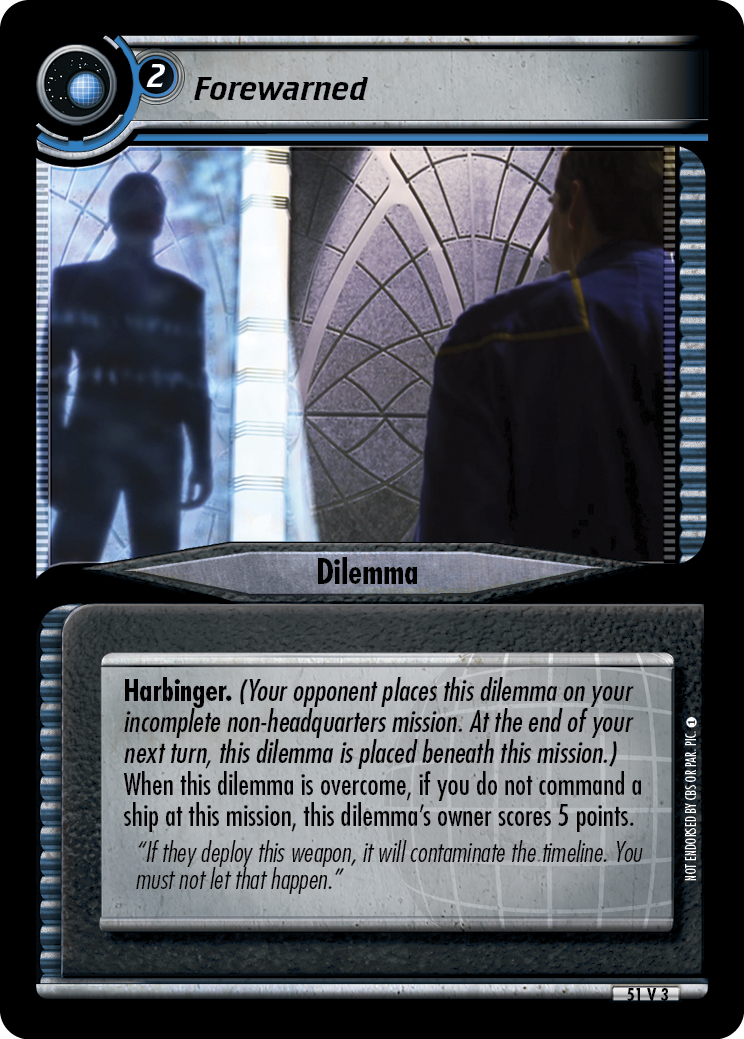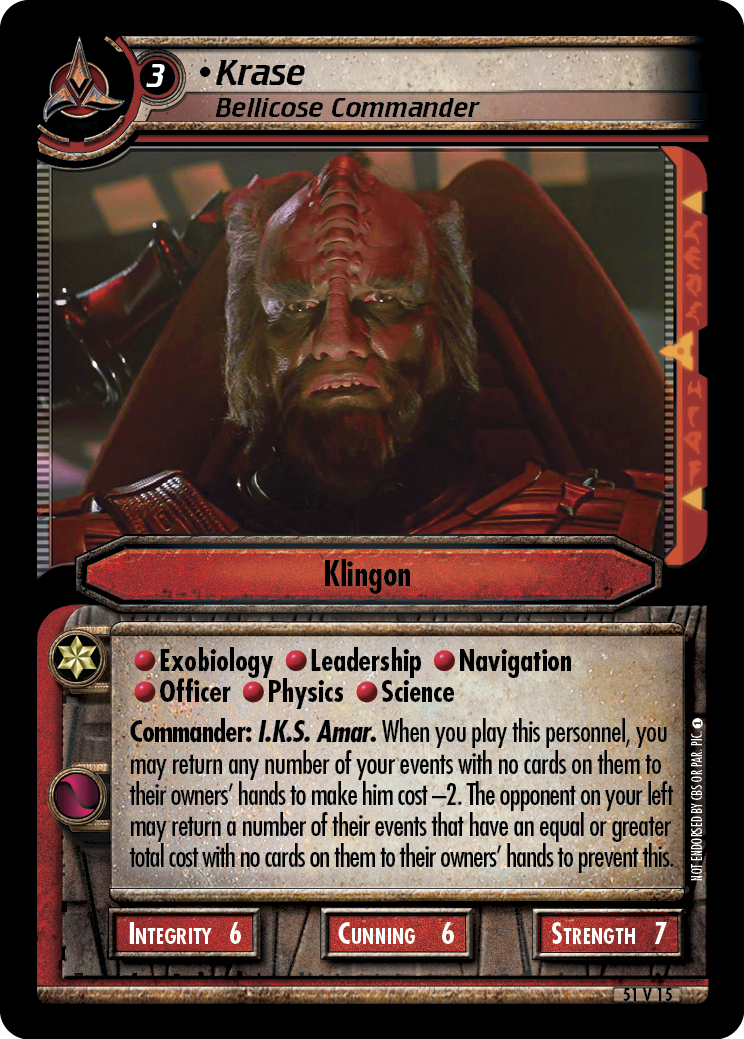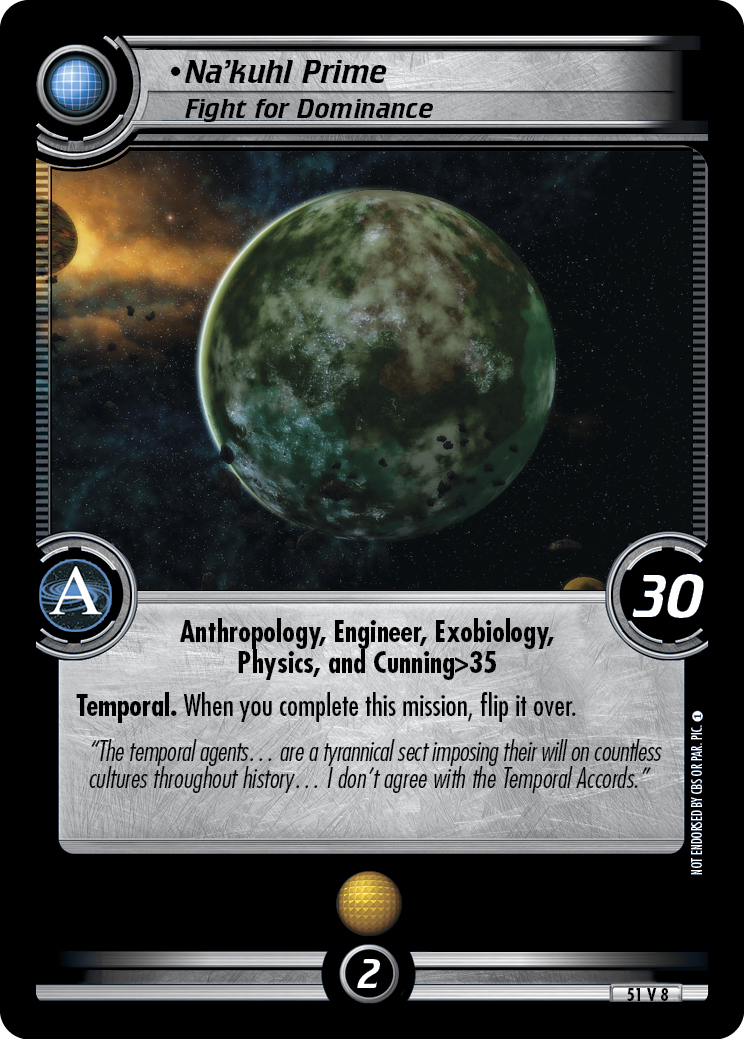All Categories • Continuing Committee • Organized Play • Rules Committee • Deck Designs • Virtual Expansions
Card Extras • Special Events • Tournament Reports • Everything Else • Spotlight Series • Contests
Strategy Articles
How to Win Games by Influencing People
by Richard New, All Our Yesterdays Lead Designer
14th August 2020
All Our Yesterdays, the fifty-first Second Edition expansion releases Friday, August 28, 2020. This is the first of several expansions focusing on interactive strategies, drawing from different eras of the Star Trek universe. The twenty-seven (27) cards in All Our Yesterdays encompasses the pre-TNG Star Trek universe. Before we get to the fun, however, allow me to introduce our design team.
Richard “The Guardian” New heads up his second full expansion. This is the seventh project he has helped shepherd into fruition.
Lucas “edgeofhearing” Thompson is the brainchild of vast swaths of the cards you will see in the upcoming weeks. This is his seventh project.
Alexey “Ashbey” Korolev added several seeds the rest of the team brought to fruition after his departure. This will be his third expansion credit.
Nathan “GooeyChewie” Miracle helped in several key moments as the Second Edition Design Leader, advising with his experience from his previous seven expansions.
Before I begin the expansion discussion in earnest, I’d like to thank everyone else that put time and effort into trying to get this set right. Specifically, the playtesters deserve no small amount of recognition. I have a recollection from the Q&A for The Undiscovered Country, back before I had started design work for the Continuing Committee. Someone asked for stories about cut cards and the reply back was that there really weren’t any. That each card evolved during playtesting, but the goals remained constant. And each card slot represented a goal. I thought that was odd at the time, but now I know the feeling. In my experience there’s always been a fair amount of throwing things at the wall to see what stuck in early versions. But here, we really went into this one with some pretty well-defined ideas about what we wanted each of the sections of the expansion to do. And while we lost one of them because the idea couldn’t be massaged into place, I want to thank the playtesters for allowing us to continue to iterate our ideas. We certainly understood that they are used to seeing unpopular things get axed early and it must have tried some patience to instead have those ideas be given new life over and over again. What made it through is a testament to those that were able to give negative impressions of cards and come back in the next version with a fresh outlook.
The designers of All Our Yesterdays discussed early what we considered to be interaction. To focus myself, I sorted non-dilemma interaction into three categories.
(1) Times when players’ cards are meant to “touch.”
This is meant to illustrate that interaction involves breaking out of a world of solitaire in which some decks are designed to operate. Sometimes you get benefits just from visiting an opponent’s missions, like Shinzon (Devious Tactician), or from hanging out with an opponent’s personnel, like Odo Founder (Adept Imposter). Sometimes this includes battle, like Invasion Plans. Often, these types of interaction leave a player open to retaliation from an opponent that might be playing an interactive deck of their own. You might rethink leaving Bochra (Loyal Centurion) at an opponent’s mission if they are playing Borg.
(2) Times when a player alters the other player’s resources.
This is probably the largest section of interactive material. After all, it is the easiest to make and the most obviously useful. Many battle cards fall into this category too. Whether they kill, capture, or assimilate personnel or damage a ship, often the result is a drain of some sort of resource. Battle also illustrates that cards can fall into several of my categories of interaction. Your personnel have to be on the same ship or planet to pick a fight, so they must by definition “touch” the opponent’s cards. However, cards like Dukat (Liberator and Protector) never even have to leave their owners’ missions to change the state of an opponent’s game.
(3) Times when a player alters the game plan of another player.
This is hard to do reliably, both in game and deck design. Sometimes it can be done by simply playing a specific deck. You could choose to go planet first against a Borg Dissident deck so you can head back to your headquarters each turn to fend off The New Resistance until the midgame. Or keeping your hand full against a Dominion opponent, to prevent losing a turn from Crippling Strike. Sometimes simply a sustained assault by cards in the second category are enough to change the course of a game, like going draw-and-play to keep a low hand size against a Maquis denial deck. But individual cards that make an opponent stop what they are doing and change course mid-game are rare, and should be.
In All Our Yesterdays, we looked at cards aiming at all three categories to appeal to the disparate players in our community.
Our suite of dilemmas demonstrate a new keyword that we hope sees love in the future. I would put our dilemmas mostly in the first category, spilling into the second and third. With them, we introduce a new loaded keyword: Harbinger. The loaded text for the Harbinger keyword reads, "Your opponent places this dilemma on your incomplete non-headquarters mission. At the end of your next turn, this dilemma is placed beneath this mission." So, we start with these dilemmas “touching” the opponent’s missions. They have several effects while they are in play, but often they alter the resources available during mission attempts at that mission or encourage or discourage temporary plan changes.
From a story perspective, the Harbinger dilemmas represent messages for good or for ill from the future that you can follow or ignore. With Forewarned, Future Guy warns of continued Xindi attacks. Upon encountering, a player could listen to the warning and take a side trip or allow an enemy to proceed with their spoiled plans unchallenged. In this set, we see a couple of examples of characters that might be interested in these communications, including a small connection to Starfleet.
The next major block of cards is the Klingons, representing the second of the three categories of interaction. I know what some players might say: the Klingons have gotten enough love. We understand. Being limited to pre-TNG era affiliations gave us few choices for target affiliations. And up until the end of testing, we had a larger cluster of Romulan cards as well, but they got cut based on some last-minute testing, indicating that they were doing their job too well. You know those Romulans…
After the Organian Peace Treaty, conflict between the Federation and Klingons couldn’t be direct. Klingons used tactics that ranged from shadow conflicts to economic manipulation, and while this aggression seemed to continue past the original series into the movies, we never saw a return to bloodier confrontation. The designers latched onto this pecuniary clash in All Our Yesterdays. The Klingons give their opponents a benefit in order to get a head start. And their opponents have the same option as Kirk in “A Private Little War.” They can let the Klingons keep their lead or play their game and offer the same value back. Take Krase (Bellicose Commander). When you play him, you may return any number of your events to your hand for a discount. Your opponent can cancel the discount by returning events to their hand. The events must be of equal or greater cost compared to the events you return, so you’ll have to return an event with a cost of at least 1 or it would be pretty easy for an opponent to sit on their thumbs and cancel the discount with no effort. After all, null is greater than or equal to zero.
And while these Klingons can be used in any Klingon deck, bringing their era’s battle strategy to any other scheme, we do have a card that encourages use with other ![]() Klingons. It has an economic choice of its own for the opponent, but you’ll have to wait for that.
Klingons. It has an economic choice of its own for the opponent, but you’ll have to wait for that.
Finally, I would like to introduce Temporal missions. Utilizing the rules for dual-sided mission introduced in A Less Perfect Union, completing these missions alter the universe itself, changing the location to a different point in space-time. For instance, Na’kuhl Prime represents Vosk’s homeworld, where he developed a form of stealth time travel. Once you’ve helped him do so, the mission flips to Alternate 1944 Earth. (As a reminder, the mission is still complete, so you may not attempt it again. Dilemmas beneath, and all cards on that mission are now at the new location. The only thing that inherently changes when a mission flips is which side is considered to be in play.) And now it’s your opponent’s ball. Alternate 1944 Earth allows you to “Temporal Conduit” the dilemmas you faced here to your next mission. And you can continue to do this until they send a party back in time to stop you. Essentially, the opponent must complete a Smuggling Run for no points, possibly to the detriment of a turn or two, and giving you the option to interact further as they wait to undo the damage you caused to the flow of time. Or they can ignore it and suffer the consequences. An unplanned trip to restore the timeline certainly qualifies for my third category of interaction.
And like Starfleet having an (undisclosed) connection to the Harbinger dilemmas, the Federation is the affiliation with the strongest attraction to the Temporal missions. Spock (Transtemporal Truth-Teller), for instance, seems to get a kick out of changing time. (Must be his recent resurrection…)
There are, of course, other cards in the expansion that don’t fit into these three groups. The Romulans that survived the last culling can add some new options to their decks. Some Andorians pop their antennaed heads above the ice to join the Vulcans, Tellarites, and others as this expansion’s species-specific sub-cluster. And some strong female characters could succeed in bringing out new deck types. We hope you enjoy All Our Yesterdays.
Discuss this article in this thread.
Back to Archive index















